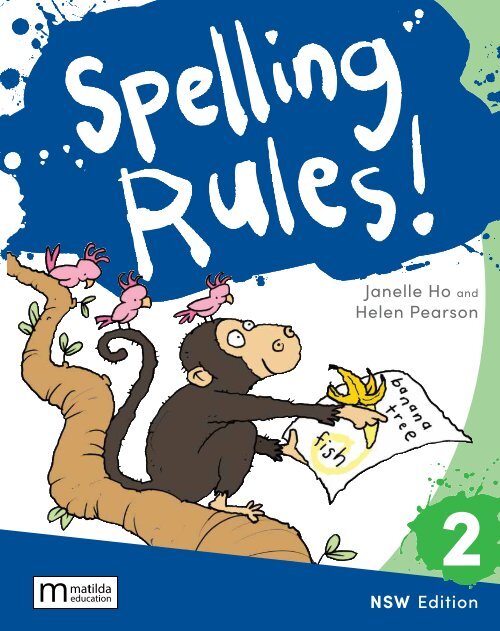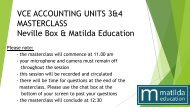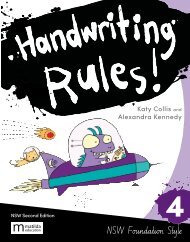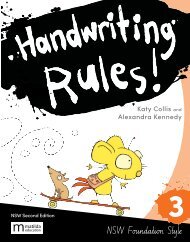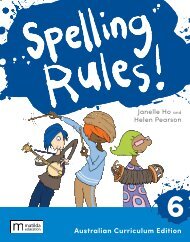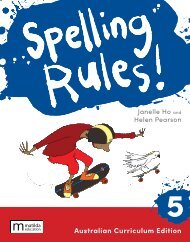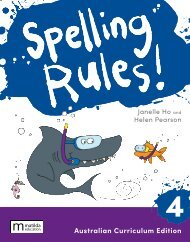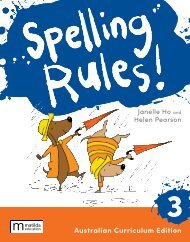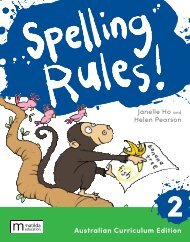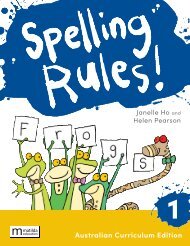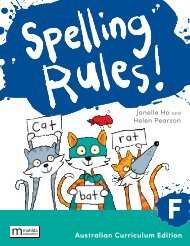Spelling Rules 2 NSW sample/look inside the book
You also want an ePaper? Increase the reach of your titles
YUMPU automatically turns print PDFs into web optimized ePapers that Google loves.
Janelle Ho and<br />
Helen Pearson<br />
2<br />
<strong>NSW</strong> Edition
Janelle Ho and<br />
Helen Pearson<br />
STUDENT<br />
BOOK<br />
2<br />
<strong>NSW</strong> Edition<br />
Name:<br />
Class:
Contents<br />
Scope and Sequence.......................................................... 3<br />
Note to Teachers and Parents.......................................... 4<br />
Units 1–35.............................................................................. 6–75<br />
List Words in Unit Order..................................................... 76<br />
List Words in Alphabetical Order..................................... 78<br />
<strong>Spelling</strong> <strong>Rules</strong> and Tips...................................................... 80<br />
SLLURP<br />
SLLURP summarises <strong>the</strong> spelling strategies that you can use to learn new words.<br />
Say<br />
Listen<br />
Look<br />
Understand<br />
Remember<br />
Practise<br />
Say <strong>the</strong> word carefully and slowly to yourself.<br />
Listen to how each part of <strong>the</strong> word sounds in sequence.<br />
Look at <strong>the</strong> patterns of letters in <strong>the</strong> word and <strong>the</strong> shape<br />
of <strong>the</strong> word.<br />
Understand rules, word meanings and word origins.<br />
Remember all <strong>the</strong> similar words you can already spell<br />
and relate this knowledge to any new word.<br />
Practise writing <strong>the</strong> word until it is firmly fixed in your<br />
long-term memory.<br />
2 <strong>Spelling</strong> <strong>Rules</strong>! Student Book 2 (ISBN 9780655092599) © Janelle Ho, Helen Pearson/Matilda Education Australia
Scope and Sequence This scope and sequence chart is based on <strong>the</strong> requirements of <strong>the</strong> <strong>NSW</strong> Curriculum.<br />
Unit<br />
1<br />
2<br />
3<br />
4<br />
5<br />
6<br />
7<br />
8<br />
9<br />
10<br />
11<br />
12<br />
13<br />
14<br />
15<br />
16<br />
17<br />
18<br />
19<br />
20<br />
21<br />
22<br />
23<br />
24<br />
25<br />
26<br />
27<br />
28<br />
29<br />
30<br />
31<br />
32<br />
33<br />
34<br />
35<br />
Vowels Consonants Letter<br />
patterns<br />
split digraphs:<br />
a-e, i-e, o-e,<br />
e-e, u-e<br />
short vowel<br />
sounds<br />
semi-vowel y<br />
blends and<br />
digraphs<br />
blends and<br />
digraphs<br />
medial<br />
double<br />
letters<br />
ck, medial<br />
ck<br />
tch, medial<br />
tch<br />
dge, medial<br />
dge<br />
Morphology<br />
-ed, -ing: dropping<br />
final ‘e’<br />
-ed, -ing: doubling<br />
final consonant<br />
-es, -ed: changing<br />
‘y’ to ‘i’<br />
Homophones/<br />
Homographs<br />
Topic words<br />
place, scrape, time, unite, slope, whole, complete,<br />
squeeze, rule, cure<br />
beg, scan, clap, strap, swim, begin, block, throb,<br />
thud, scrub<br />
lady, pony, busy, ready, sorry, worry, carry, hurry,<br />
reply, apply<br />
ar -er, -est arm, car, park, dark, star, start, hard, barn, smart,<br />
farmer<br />
letter, little, bottle, rabbit, cuddle, riddle, ripple,<br />
tunnel, borrow, pillow<br />
or, ore<br />
aw, oor<br />
-es<br />
compound words:<br />
forefor/four/fore<br />
chicken, bucket, ticket, packet, pocket, jacket,<br />
cricket, bracket, backpack, limerick<br />
itchy, witch, stitch, catch, hatch, watch, fetch,<br />
stretch, hutch, kitchen<br />
edge, hedge, badge, fridge, bridge, judge, smudge,<br />
dodge, fidget, gadget<br />
for, fork, torn, short, sport, more, fore, snore, chore,<br />
explore<br />
saw, draw, claw, straw, crawl, lawn, prawn, poor,<br />
door, floor<br />
ar, al -ward/-wards war, warn, ward, swarm, award, reward, towards,<br />
walk, talk, chalk<br />
ough, augh irregular verbs ought, bought, brought, fought, thought, sought,<br />
caught, taught, naughty, daughter<br />
silent<br />
letters: kn,<br />
wr, silent ‘t’<br />
air, are,<br />
ear<br />
ear, eer<br />
er, ir<br />
ear, or, ur<br />
-er, -est: practising<br />
spelling rules<br />
-er, -or: practising<br />
spelling rules<br />
compound words:<br />
airstare/stair,<br />
bare/<br />
bear, where/wear<br />
tear, wind, bow;<br />
hear/here, dear/deer<br />
people,<br />
occupations<br />
knife, knowledge, wrong, wrist, wriggle, listen, often,<br />
castle, bustle, whistle<br />
pair, stair, chair, repair, airport, rare, share, square,<br />
wear, bear<br />
fear, hear, tear, clear, spear, weary, appear, deer,<br />
peer, cheer, queer<br />
fern, serve, person, perfect, stir, shirt, first, dirty,<br />
thirsty, birthday<br />
turn, hurt, burst, nurse, curly, work, worth, learn,<br />
earth, search<br />
farmer, leader, shopper, follower, visitor, collector,<br />
editor, author, narrator, illustrator<br />
re-, un-, dis-<br />
redo, reread, rejoin, reunite, unkind, unfair, untidy,<br />
disagree, disappear, disobey<br />
u, o lung, pluck, under, love, done, above, front, month,<br />
among, money<br />
ou, oo -er, -est young, touch, cousin, country, double, rough, tough,<br />
enough, flood, blood<br />
-ful: changing ‘y’<br />
to ‘i’<br />
-ly: changing ‘y’<br />
to ‘i’<br />
days of <strong>the</strong> week<br />
joyful, useful, playful, cheerful, helpful, careful,<br />
painful, awful, colourful, beautiful<br />
sadly, loudly, slowly, nicely, rudely, quickly, quietly,<br />
crossly, kindly, happily<br />
Monday, Tuesday, Wednesday, Thursday, Friday,<br />
Saturday, Sunday, today, tomorrow, because<br />
o, a, au foggy, along, belong, toffee, homophone, wasp,<br />
wand, watch, wander, sausage<br />
contractions<br />
I’ll, he’s, it’s, isn’t, can’t, don’t, doesn’t, didn’t, won’t,<br />
we’re<br />
soft c<br />
silent letters:<br />
mb, mn<br />
ch<br />
Skill Focus<br />
REVISION<br />
REVISION<br />
REVISION<br />
REVISION<br />
cents/scent,<br />
scene/seen<br />
REVISION<br />
compound words<br />
with ache<br />
compound words<br />
with no, any,<br />
some, every<br />
Word List<br />
city, cent, scent, scene, once, cancel, cycle, cylinder,<br />
science, scissors<br />
lamb, limb, dumb, numb, thumb, comb, climb,<br />
autumn, column, plumber<br />
school, ache, choir, character, chorus, chameleon,<br />
stomach, anchor, chef, machine<br />
no one, nothing, nowhere, somebody, something,<br />
anyone, anything, ano<strong>the</strong>r, everyone, everywhere<br />
<strong>Spelling</strong> <strong>Rules</strong>! Student Book 2 (ISBN 9780655092599) © Janelle Ho, Helen Pearson/Matilda Education Australia<br />
3
Note to teachers and parents<br />
<strong>Spelling</strong> <strong>Rules</strong>!<br />
Some students are natural spellers. But <strong>the</strong> vast majority of students need formal, systematic and sequential<br />
instruction about <strong>the</strong> way spelling works and <strong>the</strong> strategies <strong>the</strong>y can use to become independent, confident spellers.<br />
The <strong>Spelling</strong> <strong>Rules</strong>! program is based on sound linguistic and pedagogical <strong>the</strong>ory. It is informed by research into how<br />
students of different ages acquire and apply spelling skills, and how those skills move from <strong>the</strong> working to <strong>the</strong> longterm<br />
memory. The program closely follows <strong>the</strong> <strong>NSW</strong> English Curriculum. <strong>NSW</strong> Curriculum references are provided<br />
in <strong>the</strong> two Teacher Resource Books. The program consists of seven Student Books.<br />
Each student <strong>book</strong> contains units of work, with each unit designed to be used over <strong>the</strong> course of a week. The content<br />
of each unit follows <strong>the</strong> suggested instructional sequence in <strong>the</strong> <strong>NSW</strong> English syllabus. Each unit simultaneously<br />
develops new skills and reinforces skills from previous units. Where appropriate, topic words from o<strong>the</strong>r curriculum<br />
areas are included. When spelling rules and tips are introduced, only known sounds and letter patterns are used so that<br />
students focus on one skill at a time. Regular revision units enable teachers to assess student progress and reinforce<br />
key rules and patterns from previous units. Books 1 to 6 also include a simple reflection activity that encourages<br />
students to assess <strong>the</strong>ir own progress and provides you with a starting point for discussion.<br />
<strong>Spelling</strong> knowledge<br />
Learning to spell involves developing different kinds of spelling knowledge:<br />
T Kinaes<strong>the</strong>tic knowledge – <strong>the</strong> physical feeling when saying different sounds and words, and when writing<br />
<strong>the</strong> shapes of letters and words<br />
T Phonological knowledge – how a word sounds and <strong>the</strong> patterns of sounds in words<br />
T Visual knowledge – how letters and words <strong>look</strong> and <strong>the</strong> visual patterns in words<br />
T Morphemic knowledge – <strong>the</strong> meaning or function of words or parts of words<br />
T Etymological knowledge – <strong>the</strong> origins and history of words and <strong>the</strong> effect this has on spelling patterns.<br />
Icons used in Student Book 2<br />
The following icons identify <strong>the</strong> main spelling strategy that students will use to complete an activity.<br />
Say <strong>the</strong> word. (Kinaes<strong>the</strong>tic knowledge)<br />
These activities ask students to experience how<br />
sounds feel in <strong>the</strong> mouth and jaw. Changing <strong>the</strong> positions<br />
of <strong>the</strong> jaw, lips and tongue changes <strong>the</strong> sounds we make.<br />
Encourage students to pronounce <strong>the</strong> sounds and words<br />
accurately. If <strong>the</strong>y mispronounce a sound or word, <strong>the</strong>y<br />
may misrepresent it in writing.<br />
Listen to <strong>the</strong> word. (Phonological knowledge)<br />
These activities focus on discriminating between<br />
different sounds and breaking up words into syllables or<br />
individual sound segments (phonemes).<br />
Look at <strong>the</strong> word. (Visual knowledge) These<br />
activities help students to see how <strong>the</strong> sound<br />
is represented using combinations of letters, and to<br />
associate this visual pattern with what <strong>the</strong>y are hearing.<br />
Students will develop <strong>the</strong> ability to know when a word<br />
does or does not ‘<strong>look</strong> right’.<br />
Understand <strong>the</strong> word. (Morphemic and<br />
etymological knowledge) These activities focus<br />
on word meanings, word families, prefixes and suffixes,<br />
spelling rules, word origins and so on, which help embed<br />
spelling in <strong>the</strong> long-term memory.<br />
Practise writing <strong>the</strong> word. (Kinaes<strong>the</strong>tic<br />
knowledge) These activities develop students’<br />
awareness of <strong>the</strong> physical movement involved in writing<br />
<strong>the</strong> word. By practising writing <strong>the</strong> word a number of<br />
times and in different contexts, <strong>the</strong> spelling becomes<br />
embedded in <strong>the</strong> long-term memory.<br />
I can do this.<br />
I am not sure.<br />
I need help.<br />
This icon highlights useful spelling rules.<br />
This icon tells students that a special clue<br />
or hint is provided for an activity. It may<br />
be a spelling, grammar or punctuation<br />
convention, or a definition of a useful term.<br />
Encourages students to assess <strong>the</strong>ir<br />
progress across each unit.<br />
4 <strong>Spelling</strong> <strong>Rules</strong>! Student Book 2 (ISBN 9780655092599) © Janelle Ho, Helen Pearson/Matilda Education Australia
Student Book 2<br />
Units of work<br />
Student Book 2 contains 35 weekly units of work. Groups of units focus on different phonemes that represent<br />
<strong>the</strong> same sound. The suffixes taught in Book 1 are consolidated using new words. They are also elaborated on<br />
by using spelling rules such as <strong>the</strong> dropping of silent ‘e’ and <strong>the</strong> doubling of <strong>the</strong> final consonant. More suffixes<br />
(ful, ly) and prefixes (re, un, dis) are taught and homophones are explained and practised. Finally, <strong>the</strong> concepts<br />
of irregular verbs, silent letters and contractions are also presented. See <strong>the</strong> Scope and Sequence chart<br />
on page 3 for more information.<br />
Word lists<br />
In Student Book 2, each unit (except Revision) has a list of ten spelling words. The words are selected<br />
to support <strong>the</strong> learning focus and spelling strategies in <strong>the</strong> unit. The list also includes words from o<strong>the</strong>r<br />
curriculum areas such as ma<strong>the</strong>matics, science and social sciences. Where appropriate, Aboriginal Australian<br />
English words are also included.<br />
SLLURP<br />
Each word list begins with a reminder for students to SLLURP. SLLURP summarises <strong>the</strong> strategies that will<br />
help spelling move from students’ working memory to <strong>the</strong>ir long-term memory. These strategies are provided<br />
on page 2, for easy reference.<br />
Unit at a glance<br />
Space to practise<br />
list words<br />
List words support <strong>the</strong><br />
learning of <strong>the</strong> spelling<br />
focus for <strong>the</strong> unit. Words<br />
come from across <strong>the</strong><br />
curriculum<br />
My own words –<br />
students can write <strong>the</strong>me<br />
words, personal words<br />
or extension words, or<br />
practise o<strong>the</strong>r words<br />
with <strong>the</strong> same spelling<br />
focus. Adapt this section<br />
to suit <strong>the</strong> needs of your<br />
class<br />
<strong>Spelling</strong> focus<br />
highlighted in<br />
colour<br />
25<br />
Say Listen Look Understand Remember Practise<br />
joyful<br />
useful<br />
playful<br />
cheerful<br />
helpful<br />
careful<br />
painful<br />
awful<br />
colourful<br />
beautiful<br />
My own words<br />
2<br />
SLLURP reminds<br />
students about<br />
strategies <strong>the</strong>y can use<br />
to learn <strong>the</strong> words<br />
What do you<br />
call a cheerful<br />
flea?<br />
Words for quantities sometimes end in ful. Handful is an example. Use <strong>the</strong><br />
pictures as clues to write <strong>the</strong>se quantities.<br />
l<br />
joy<br />
play<br />
help<br />
harm<br />
use<br />
care<br />
hope<br />
peace<br />
Add ful to <strong>the</strong>se words.<br />
ful<br />
ful<br />
A hop-timist.<br />
Unit banner<br />
features <strong>the</strong> spelling<br />
focus in <strong>the</strong> context<br />
of a fun joke<br />
Use <strong>the</strong> clue to find a list word to fit each sentence.<br />
I can do this.<br />
I am not sure.<br />
I need help.<br />
54 <strong>Spelling</strong> <strong>Rules</strong>! Student Book 2 (ISBN 9780655092599) © Janelle Ho, Helen Pearson/Matilda Education Australia<br />
<strong>Spelling</strong> <strong>Rules</strong>! Student Book 2 (ISBN 9780655092599) © Janelle Ho, Helen Pearson/Matilda Education Australia<br />
55<br />
3<br />
My nickname is Smiley as I am always<br />
mood)<br />
Our classroom is bright and<br />
Did you see <strong>the</strong><br />
I baked <strong>the</strong> cake without sugar. It tasted<br />
4<br />
5<br />
beauty<br />
pity<br />
z<br />
careful<br />
colourful<br />
. (in a good<br />
. (has many colours)<br />
sunrise this morning? (pretty)<br />
If a word ends in y, change y to i before adding ful.<br />
duty<br />
dutiful<br />
Add ful to <strong>the</strong>se words.<br />
mercy<br />
plenty<br />
Make your own mnemonic. You can use <strong>the</strong> underlined<br />
part as a hint.<br />
. (bad)<br />
A mnemonic is a trick to help us remember something.<br />
Peace and piece are homophones.<br />
The mnemonic I’d like a piece of pie can help you<br />
remember <strong>the</strong> difference.<br />
Sequenced activities<br />
– each activity focuses<br />
on a specific spelling<br />
strategy. Some activities<br />
refer to content in o<strong>the</strong>r<br />
curriculum areas<br />
Icons identify <strong>the</strong><br />
main spelling strategy<br />
students will use in<br />
an activity<br />
<strong>Spelling</strong> tips and<br />
rules introduced<br />
when students need<br />
<strong>the</strong>m to complete an<br />
activity<br />
Reflection allows<br />
students to assess<br />
<strong>the</strong>ir progress<br />
<strong>Spelling</strong> <strong>Rules</strong>! Teacher Resource Book K-2<br />
Full teacher support for Student Book 2 is provided by <strong>Spelling</strong> <strong>Rules</strong>! Teacher Resource Book K–2. Here you will<br />
find valuable background information about spelling development and spelling knowledge, along with practical<br />
resources, such as:<br />
T teaching tips for every unit in Student Book 2 T guidelines for assessing and diagnosing errors<br />
T extra word lists<br />
T activities to support struggling spellers<br />
T strategies for teaching spelling<br />
T worthwhile extension for more able spellers.<br />
<strong>Spelling</strong> <strong>Rules</strong>! Student Book 2 (ISBN 9780655092599) © Janelle Ho, Helen Pearson/Matilda Education Australia<br />
5
l<br />
What<br />
snake is good<br />
at sums?<br />
An adder.<br />
Say Listen Look Understand Remember Practise<br />
place<br />
scrape<br />
time<br />
unite<br />
slope<br />
whole<br />
complete<br />
squeeze<br />
rule<br />
cure<br />
My own words<br />
l<br />
Write list words in <strong>the</strong> correct tree.<br />
i–e<br />
e–e<br />
o–e<br />
u–e<br />
2<br />
Write <strong>the</strong> word. Then write it again, adding e to change <strong>the</strong> vowel sound.<br />
6 <strong>Spelling</strong> <strong>Rules</strong>! Student Book 2 (ISBN 9780655092599) © Janelle Ho, Helen Pearson/Matilda Education Australia
3<br />
Write two words that begin with <strong>the</strong> same sound as <strong>the</strong> picture.<br />
list word extra word list word extra word<br />
z<br />
Homophones are words<br />
that sound <strong>the</strong> same,<br />
but are spelt differently.<br />
hole = empty space<br />
whole = all of<br />
4<br />
Choose <strong>the</strong> correct homophone.<br />
Shane ate <strong>the</strong><br />
cake.<br />
Jane dug a<br />
in <strong>the</strong> sand.<br />
I tore a<br />
in my pants.<br />
Did you see <strong>the</strong><br />
movie?<br />
5<br />
place<br />
Look for small words <strong>inside</strong> <strong>the</strong> list word. Write <strong>the</strong> small words.<br />
whole<br />
unite<br />
Words with a silent e drop <strong>the</strong> e before adding ed or ing.<br />
Smiling, <strong>the</strong> monkey waved at me.<br />
6<br />
Follow <strong>the</strong> pattern.<br />
place + ed = placed<br />
place + ing = placing<br />
unite + ed = unite + ing =<br />
rule + ed = rule + ing =<br />
squeeze + ed =<br />
squeeze + ing =<br />
I can do this.<br />
I am not sure.<br />
I need help.<br />
<strong>Spelling</strong> <strong>Rules</strong>! Student Book 2 (ISBN 9780655092599) © Janelle Ho, Helen Pearson/Matilda Education Australia<br />
7
2<br />
Why couldn’t <strong>the</strong><br />
leopard escape<br />
from <strong>the</strong> zoo?<br />
Because he<br />
was always<br />
spotted.<br />
Say Listen Look Understand Remember Practise<br />
beg<br />
scan<br />
clap<br />
strap<br />
swim<br />
begin<br />
block<br />
throb<br />
thud<br />
scrub<br />
My own words<br />
Write <strong>the</strong> vowels in <strong>the</strong> first<br />
l<br />
column. Then write words with<br />
short and long vowels to fill in <strong>the</strong> spaces.<br />
vowels short sound long sound<br />
a<br />
mad<br />
hop<br />
Pete<br />
slide<br />
huge<br />
If a word has a short<br />
vowel sound and ends<br />
in a single consonant,<br />
double <strong>the</strong> consonant<br />
before adding ed or ing.<br />
2<br />
Write <strong>the</strong> word when ing is added.<br />
beg strap throb<br />
scan begin thud<br />
clap scrub block<br />
8 <strong>Spelling</strong> <strong>Rules</strong>! Student Book 2 (ISBN 9780655092599) © Janelle Ho, Helen Pearson/Matilda Education Australia
3<br />
Circle <strong>the</strong> pictures that have short vowel sounds.<br />
4<br />
Write <strong>the</strong> missing letter.<br />
beg ––– ed rub ––– ed spot ––– ed plan ––– ed<br />
pat ––– ed stop ––– ed skip ––– ed hum ––– ed<br />
z<br />
Most words add ed to make <strong>the</strong> past tense. Some words<br />
change. They are called irregular verbs. swim swam<br />
5<br />
Follow <strong>the</strong> pattern.<br />
swim sing stink begin drink<br />
swam s ng st beg<br />
6<br />
Write a sentence for each word.<br />
thudded<br />
began<br />
I can do this.<br />
I am not sure.<br />
I need help.<br />
<strong>Spelling</strong> <strong>Rules</strong>! Student Book 2 (ISBN 9780655092599) © Janelle Ho, Helen Pearson/Matilda Education Australia<br />
9
3<br />
What beans<br />
can’t you grow<br />
in a garden?<br />
Jelly beans.<br />
Say Listen Look Understand Remember Practise<br />
lady<br />
pony<br />
busy<br />
ready<br />
sorry<br />
worry<br />
carry<br />
hurry<br />
reply<br />
apply<br />
My own words<br />
l<br />
Draw a line between each<br />
sound. Underline each syllable.<br />
lady busy ready<br />
sorry worry hurry<br />
carry reply apply<br />
2<br />
Say each list word. Sort <strong>the</strong><br />
words by <strong>the</strong> sound y makes.<br />
y in puppy<br />
y in cry<br />
3<br />
Write a list word for each group. Add ano<strong>the</strong>r word ending in a short y sound.<br />
animals people feelings actions<br />
bunny aunty angry study<br />
10 <strong>Spelling</strong> <strong>Rules</strong>! Student Book 2 (ISBN 9780655092599) © Janelle Ho, Helen Pearson/Matilda Education Australia
4<br />
Proofread this story. The story has six words that are incorrect. Circle <strong>the</strong><br />
mistakes. Then write <strong>the</strong> correct spelling of <strong>the</strong> words in <strong>the</strong> boxes.<br />
Tony’s front tooth was wobly. When it fell out, he<br />
lost it. He was not heppy as he planned to put it<br />
under his pillow for <strong>the</strong> tooth fairy. Tony felt silly,<br />
but he decided to write a not.<br />
Dear Tooth Fary,<br />
I am sory I lost my tooth.<br />
Please leave a shiny coin for me.<br />
Tony<br />
In <strong>the</strong> morning Tony rubed his eyes and felt under<br />
his pillow. He found two dollars! Wasn’t he lucky?<br />
If a word ends in y, change y to i before adding es or ed.<br />
To make <strong>the</strong> plural, add es. lady ladies<br />
To change <strong>the</strong> verb, add es or ed.<br />
worry worries, worried cry cries, cried<br />
5<br />
Write <strong>the</strong> word when es or ed is added.<br />
pony<br />
baby<br />
plural<br />
carry<br />
reply<br />
apply<br />
past tense<br />
I can do this.<br />
I am not sure.<br />
I need help.<br />
<strong>Spelling</strong> <strong>Rules</strong>! Student Book 2 (ISBN 9780655092599) © Janelle Ho, Helen Pearson/Matilda Education Australia<br />
11
4<br />
Why did<br />
<strong>the</strong> dog get<br />
arrested?<br />
He didn’t pay<br />
his barking<br />
fee!<br />
Say Listen Look Understand Remember Practise<br />
l<br />
Make ar words.<br />
arm<br />
car<br />
park<br />
dark<br />
star<br />
start<br />
p<br />
d<br />
sh<br />
ark<br />
m<br />
b<br />
hard<br />
barn<br />
smart<br />
st<br />
farmer<br />
My own words<br />
p<br />
art<br />
ch<br />
d<br />
m<br />
2<br />
Find a small word in <strong>the</strong> big word. Write a different small word for each.<br />
card start bark<br />
harm barn cart<br />
farmer heart fa<strong>the</strong>r<br />
12 <strong>Spelling</strong> <strong>Rules</strong>! Student Book 2 (ISBN 9780655092599) © Janelle Ho, Helen Pearson/Matilda Education Australia
3<br />
Finish <strong>the</strong> letter.<br />
hard far farm dark barn yard<br />
Dear Uncle Carl,<br />
I loved staying on your<br />
. It was<br />
so<br />
at night! I liked hunting for eggs<br />
in <strong>the</strong> and in <strong>the</strong> . It was<br />
to find <strong>the</strong>m in <strong>the</strong> long grass. I wish<br />
you did not live so<br />
away.<br />
Love from Mark<br />
X X X<br />
z<br />
Adjectives are describing words. To compare two things, add<br />
er to an adjective. To compare three or more things, add est.<br />
fast faster fastest<br />
4<br />
list word<br />
add er<br />
add est<br />
There are three adjectives in <strong>the</strong> list words. Write <strong>the</strong>m down. Add er and est.<br />
5<br />
Circle two mistakes.<br />
The farmer caried his shepe to <strong>the</strong> barn.<br />
I can do this.<br />
I am not sure.<br />
I need help.<br />
<strong>Spelling</strong> <strong>Rules</strong>! Student Book 2 (ISBN 9780655092599) © Janelle Ho, Helen Pearson/Matilda Education Australia<br />
13
5<br />
What do you<br />
call a nervous<br />
insect?<br />
A jitterbug.<br />
Say Listen Look Understand Remember Practise<br />
letter<br />
little<br />
bottle<br />
rabbit<br />
cuddle<br />
riddle<br />
ripple<br />
tunnel<br />
borrow<br />
pillow<br />
My own words<br />
l<br />
The words in each ladder are<br />
missing <strong>the</strong> same double letters.<br />
Write <strong>the</strong> missing letters.<br />
ga ––– ––– op<br />
pi ––– ––– ow<br />
ba ––– ––– oon<br />
ye ––– ––– ow<br />
le ––– ––– er<br />
bu ––– ––– er<br />
ki ––– ––– en<br />
ss<br />
tt<br />
nn<br />
ll<br />
ke ––– ––– el<br />
di ––– ––– er<br />
tu ––– ––– el<br />
wi ––– ––– er<br />
le ––– ––– on<br />
blo ––– ––– om<br />
po ––– ––– um<br />
2<br />
Change one letter to make a new word.<br />
letter + b = bottle + a =<br />
borrow + u = muddle + i =<br />
giggle + wr = juggle + str =<br />
14 <strong>Spelling</strong> <strong>Rules</strong>! Student Book 2 (ISBN 9780655092599) © Janelle Ho, Helen Pearson/Matilda Education Australia
3<br />
Write a list word.<br />
4<br />
Write new double letters to make ano<strong>the</strong>r word.<br />
puzzle dribble riddle<br />
pu ––– ––– le<br />
dri ––– ––– le<br />
5<br />
Write a vowel to make different words.<br />
f ––– llow l ––– tter b ––– rrow<br />
f ––– llow l ––– tter b ––– rrow<br />
6<br />
b ––– rrow<br />
Write double consonants to find what William’s family<br />
is cooking for Grandpa’s birthday.<br />
It is Grandpa’s birthday tomorrow. We went<br />
shopping and bought his favourite foods.<br />
There will be a salad with le ––– ––– uce and<br />
ca ––– ––– ot. Dad will make Grandma’s special<br />
po ––– ––– um nu ––– ––– ets spiced with wa ––– ––– le<br />
seeds. For de ––– ––– ert, Aunty will bake her<br />
a ––– ––– le and bluebe ––– ––– y pie. The adults will<br />
likely have co ––– ––– ee after di ––– ––– er. We think<br />
Grandpa will eat it all!<br />
<strong>Spelling</strong> <strong>Rules</strong>! Student Book 2 (ISBN 9780655092599) © Janelle Ho, Helen Pearson/Matilda Education Australia<br />
I can do this.<br />
I am not sure.<br />
I need help.<br />
15
6<br />
When do<br />
chickens go to<br />
sleep?<br />
Seven<br />
o’cluck.<br />
Say Listen Look Understand Remember Practise<br />
chicken<br />
bucket<br />
ticket<br />
packet<br />
pocket<br />
jacket<br />
cricket<br />
bracket<br />
backpack<br />
limerick<br />
My own words<br />
l<br />
Find a list word for each shape.<br />
2<br />
Write list words that rhyme.<br />
rocket wicket packet<br />
16 <strong>Spelling</strong> <strong>Rules</strong>! Student Book 2 (ISBN 9780655092599) © Janelle Ho, Helen Pearson/Matilda Education Australia
3<br />
Use <strong>the</strong> first vowel to put list words in <strong>the</strong> correct bucket.<br />
a<br />
i<br />
o<br />
z<br />
Words that end in ck add ed to make <strong>the</strong> past tense.<br />
The number of syllables do not change.<br />
4<br />
Change one letter at a time to make a new word. The first set is done for you.<br />
jacket packed locked packet<br />
packet<br />
pocket<br />
docket socket ticket kicked<br />
5<br />
Say <strong>the</strong> word. Write <strong>the</strong> number of syllables in <strong>the</strong> circle.<br />
sucked jacket checked<br />
socket wicket pocketed<br />
kicked bracketed shocked<br />
I can do this.<br />
I am not sure.<br />
I need help.<br />
<strong>Spelling</strong> <strong>Rules</strong>! Student Book 2 (ISBN 9780655092599) © Janelle Ho, Helen Pearson/Matilda Education Australia<br />
17
7<br />
What do you<br />
call 10 ducks in<br />
a box?<br />
A box of<br />
quackers.<br />
l<br />
Say each word. Circle <strong>the</strong> word in each column that has a different vowel sound.<br />
borrow lady beg time cuddle<br />
pocket carry squeeze little bucket<br />
worry jacket letter ticket busy<br />
2<br />
Write <strong>the</strong> word. Remember your spelling rules!<br />
apply<br />
blame<br />
cuddle<br />
scrub<br />
worry<br />
add ed<br />
hurry<br />
chase<br />
ripple<br />
thud<br />
reply<br />
add ing<br />
3<br />
Use <strong>the</strong> clue to make a list word.<br />
Add one letter to scrap.<br />
Add two letters to beg.<br />
Change one letter in pocket.<br />
Add two letters to tick.<br />
Remove one letter from start.<br />
Change one letter in sorry.<br />
18 <strong>Spelling</strong> <strong>Rules</strong>! Student Book 2 (ISBN 9780655092599) © Janelle Ho, Helen Pearson/Matilda Education Australia
z<br />
Adjectives add er to compare two things. The er word is<br />
a comparative adjective. loud louder soft softer<br />
Some words add er to make a person or a thing. The er<br />
word is a noun. lead leader print printer<br />
4<br />
Colour <strong>the</strong> words that are comparative adjectives in blue. Colour <strong>the</strong> words that<br />
are nouns in yellow.<br />
cricketer harder worrier swimmer littler<br />
beginner busier darker readier scanner<br />
5<br />
Use <strong>the</strong> meaning to write a list word.<br />
begin<br />
end<br />
not soft<br />
not big<br />
<strong>the</strong> side of a hill<br />
word you use to say it is your fault<br />
6<br />
This story has eight words that are incorrect. Circle <strong>the</strong> mistakes. Write <strong>the</strong> correct<br />
spelling for each word on <strong>the</strong> lines.<br />
My sisters and I were playing a game of tip. Sofia was chaseing<br />
me down <strong>the</strong> sloppe when I tripped and scrapped my knee. Sally<br />
huried home to get <strong>the</strong> first aid back pack. She applyed some<br />
cream and put a plaster on <strong>the</strong> wound. The wound still smarted<br />
but I felt a lot batter. Once I felt reddy, we walked home.<br />
<strong>Spelling</strong> <strong>Rules</strong>! Student Book 2 (ISBN 9780655092599) © Janelle Ho, Helen Pearson/Matilda Education Australia<br />
19
8<br />
What goes<br />
tick-tock-ticktock-woof?<br />
A watchdog.<br />
Say Listen Look Understand Remember Practise<br />
itchy<br />
witch<br />
stitch<br />
catch<br />
hatch<br />
watch<br />
fetch<br />
stretch<br />
hutch<br />
kitchen<br />
l<br />
w<br />
d<br />
st<br />
f<br />
str<br />
c<br />
m<br />
h<br />
Write words with different first<br />
sounds.<br />
itch<br />
etch<br />
atch<br />
My own words<br />
3<br />
Write ch or tch.<br />
swi<br />
ur<br />
wi<br />
2<br />
w<br />
i<br />
a<br />
icken<br />
Write words with different vowel<br />
sounds.<br />
tch<br />
z<br />
ch can begin<br />
or end a word.<br />
tch can never<br />
begin a word.<br />
20 <strong>Spelling</strong> <strong>Rules</strong>! Student Book 2 (ISBN 9780655092599) © Janelle Ho, Helen Pearson/Matilda Education Australia
4<br />
Use list words to complete <strong>the</strong> crossword puzzle.<br />
1 2<br />
3<br />
4 5<br />
6<br />
7<br />
Across<br />
1. A in time saves nine.<br />
4. The bite on my hand is .<br />
6. A pet rabbit lives in a .<br />
7. My dog likes to sticks.<br />
Down<br />
1. Always before you exercise.<br />
2. <strong>the</strong> ball!<br />
3. Dad is cooking in <strong>the</strong> .<br />
5. When will <strong>the</strong> egg ?<br />
5<br />
Write <strong>the</strong> right word.<br />
witch = a woman who casts spells<br />
which = asks for a particular one<br />
A<br />
turned my watch into a clock.<br />
switch turns on <strong>the</strong> porch light?<br />
Words<br />
ending in<br />
tch add es<br />
to make<br />
<strong>the</strong> plural.<br />
6<br />
match<br />
watch<br />
patch<br />
Write <strong>the</strong> plural.<br />
I can do this.<br />
I am not sure.<br />
I need help.<br />
<strong>Spelling</strong> <strong>Rules</strong>! Student Book 2 (ISBN 9780655092599) © Janelle Ho, Helen Pearson/Matilda Education Australia<br />
21


